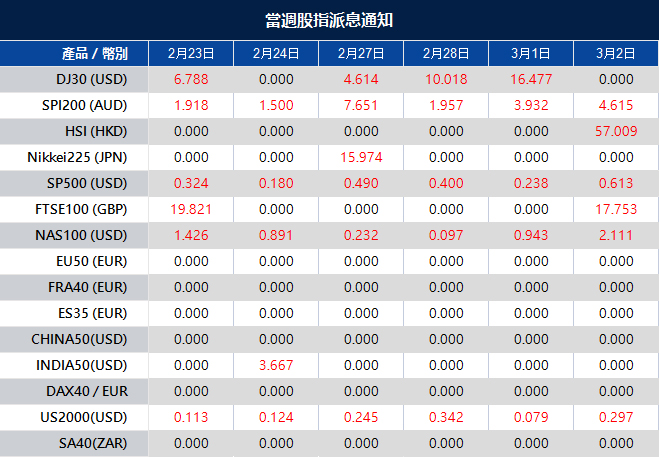US stocks suffered from daily losses last Friday, witnessing heavy selling pressure, and extended their weekly rout following data that showed the core PCE rose at the highest rate in six months. The annual Core PCE Price Index, which is also the Federal Reserve’s preferred gauge of inflation, edged higher to 4.7% and came in higher than the market expectation of 4.3%.
Therefore, the hotter-than-estimated inflation data suggested growing bets the Federal Reserve has a long way to go in its aggressive tightening crusade, making the odds of a soft landing look slimmer. Investors dumped US equities after a higher-than-anticipated jump in consumer spending in January fueled the risk of more policy tightening by Fed chair Jerome Powell in March. On top of that, the Federal Reserve (Fed) officials were also hawkish and backed the US Dollar bulls, as well as weighing on the equity markets. As per the latest reading of the FEDWATCH tool, market players price a year-end effective fed funds rate at 5.3%, versus 5.1% signaled by the US central bank in its December meeting.

The benchmarks, S&P 500 and Dow Jones Industrial Average both declined lower last Friday as the S&P 500 experienced the worst slide in 2023 after hot PCE inflation data provided a boost to the US Treasury bond yields. The S&P 500 was down 1.1% daily and the Dow Jones Industrial Average meanwhile dropped lower with a 1.0% loss for the day. Nine out of eleven sectors in the S&P 500 stayed in negative territory as the Real Estate sector and the Information Technology sector are the worst performing among all groups, losing 1.82% and 1.77%, respectively. The Nasdaq 100 meanwhile dropped the most with a 1.7% loss last Friday and the MSCI World index was down 1.2% for the day.

Main Pairs Movement
The US dollar advanced higher last Friday, marking a four-week uptrend by the end of the day, and ground near the highest levels in seven weeks amid strong United States data. The hawkish Federal Reserve concerns have provided strong support to the safe-haven greenback, as hawkish Federal Reserve (Fed) talks underpin markets bets of higher Fed rates. Cleveland Fed President Loretta Mester told CNBC on Friday that his funds’ rate was above the median in December and still thinks they need to be somewhat above 5%.
GBP/USD dropped lower last Friday with a 0.57% loss after the cable extended its intraday slide and touched a daily low near the 1.1930 mark in the late US session amid a stronger US Dollar and higher US yields. On the UK front, bets for additional rate hikes by the BoE might limit the downside for the currency. Meanwhile, EUR/USD also witnessed some selling interest and touched a daily low below the 1.0540 mark. The pair was down almost 0.45% for the day.
Gold suffered from daily losses with a 0.62% loss for the day after dropping to the lowest levels in two months below the $1810 level during the US trading session, as the strong US data underpinned hawkish Federal Reserve concerns and weighed on the yellow metal. Meanwhile, WTI Oil rebounded sharply with a 1.23% gain for the day.
Technical Analysis
EURUSD (4-Hour Chart)
The EURUSD further declined to its lowest level since early January below 1.0550 as of writing following the surprisingly high US core PCE inflation, rising to 4.7% in January, compared to market expectation of 4.3%, which provided a boost to the US Dollar. More detailed data saw Personal Income expand by 0.6% MoM also in January and Personal Spending increased by 1.8% compared to the previous month. However, it’s also worth noting that markets are already fully pricing in two more 25 basis points for Fed rate hikes in March and May. Currently, speculation the Fed will do a 50 basis points rate hike is mounting based on the stronger-than-expected growth in monthly core PCE inflation, and the CME FedWatch Tool showed the probability of a 50 bps rate hike rose to 32.9%.

From the technical perspective, the four-hour scale RSI indicator fell below the critical overselling level, suggesting that the pair were surrounded by strong bearish momentum, but investors should be aware of the corrective pullback. As the Bollinger bands, the pair continued to move along with the lower band, showing the pair was more favored to the downside path.
Resistance: 1.0788, 1.0929
Support: 1.0508, 1.0401
XAUUSD (4-Hour Chart)
Gold price remained under bearish pressure and priced at its lowest level since late December near the $1810 mark. On the back of stronger-than-expected PCE inflation data for January, the benchmark 10-year US Treasury bond yield is up more than 1% on the day near 3.95%, weighing on XAUUSD. The recent series of strong United States economic data and hawkish Federal Reserve (Fed) commentary has heightened expectations for three rate hikes this year – 25 basis points (bps) each in the March, May, and June meetings. Earlier in the US session, the US headline PCE rose 5.4% in the year to January from 5.3% and the core PCE rallied to 4.7% from a year earlier, both prints surpassing initial estimates. Markets now price the Federal Reserve terminal rate at 5.347% in July, remaining above 5% through the year.

From the technical perspective, the four-hour scale RSI indicator dropped below overselling level, suggesting that the pair was under heavy bearish pressure, but market participants should be cautious about a corrective pullback. As for the Bollinger Bands, the gold was priced below the lower band and the size between upper and lower bands gets larger, showing the downside tendency would persist shortly.
Resistance: 1850, 1870, 1900
Support: 1820, 1800
Economic Data
| Currency | Data | Time (GMT + 8) | Forecast |
| USD | Core Durable Goods Orders (MoM) (Jan) | 21:30 | 0.10% |
| USD | Pending Home Sales (MoM) (Jan) | 23:00 | 1.00% |





























